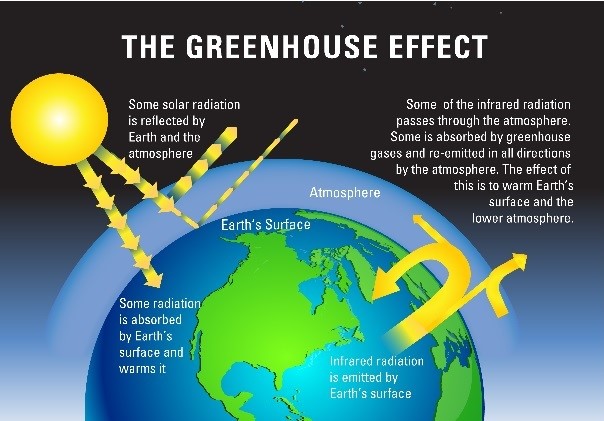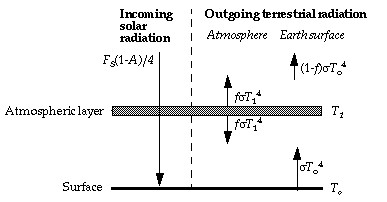Translating deep thinking into common sense
The Greenhouse Effect is a Scientific Fallacy

By Dale B. Halling
February 12, 2017
SUBSCRIBE TO SAVVY STREET (It's Free)
Can a colder body heat up a warmer body? Why is the moon hotter than the Earth, when it has no atmosphere?
Anthropogenic Global Warming (AGW) is based on the greenhouse effect. Here is how the greenhouse effect is explained. The Earth is modeled as a blackbody. A blackbody is an object that absorbs all the radiation that impinges on it and does not reflect any light. Such a body in thermal equilibrium will emit what is called blackbody radiation. The Stefan–Boltzmann law can be used to determine the temperature of a blackbody. Specifically it states that the power emitted per unit area of the surface of a black body is directly proportional to the fourth power of its absolute temperature.
I = σT4 or rearranged T = (I/σ)1/4
I is in watts per meter squared
T is the temperature in Kelvin
σ is the Stefan-Boltzmann constant (5.670367(13)×10−8 W⋅m−2⋅K−4)
here is website that will do the calculation for you http://byjus.com/stefan-boltzmann-law-calculator/
The greenhouse effect then assumes that Earth is in thermal equilibrium with the Sun and therefore the total radiative (electromagnetic) energy received from the Sun less what is reflected must equal the blackbody radiation from the Earth. The greenhouse effect hypothesis recognizes that the Earth only receives solar energy over half its surface, however it radiates over its whole surface area. Because of this the greenhouse effect hypothesis spreads the solar radiation over the whole surface of the Earth.
I = Is x πR2/(4πR2) = 343 W/m2
Is – is the solar radiation hitting the Earth and is 1370 W/m2
R is the radius of the Earth in meters
Since clouds, the atmosphere, and the ground reflect some of the light, which is called albedo, this Intensity level is further reduced by 30% or 240 W/m2. This intensity is put into the Stefan-Boltzman equation and returns a temperature of 255°K, which is negative -18°C or about 0° Fahrenheit. Based on this analysis it is clear that something else must be happening, because the Earth’s average temperature[1] is around 16°C (60° F). This makes a very convincing argument for some sort of greenhouse effect. After all we have all walked into a greenhouse on a cold day and noticed how much warmer it is than the outside temperature.
According to the greenhouse effect the reason Earth is at 16°C instead of -18°C is because of the heat absorbing components of our atmosphere. These greenhouse gases reflect the infrared light emitted from the Earth, thus trapping this extra energy.

Or here is a more technical diagram.

If you want to see the math associated with this model, you can find it in Chapter 7.3 of Introduction to Atmospheric Chemistry, by Daniel J. Jacob, Princeton University Press, 1999.
Without this greenhouse effect the Earth would be very cold according to its advocates. I have to admit that I found these arguments convincing.
Before I explain the errors in the above analysis, here is something that should cast a little doubt that the above analysis makes sense. The moon is about the same distance from the Sun as Earth and its temperature varies from 106°C during the day to -173°C during the night. Note that there appears to be some variation of opinion on the temperatures of the moon, but 106°C appears to be on the low side. Since the moon is essentially the same distance from the Sun the solar irradiance (energy) is about the same as the Earth receives. The moon has essentially no atmosphere, its atmospheric pressure is around 3×10−15 atm, which means it has an atmospheric pressure that is around a 1000 trillion times less than Earth. Since the moon has almost no atmosphere there is nothing on the moon to trap the blackbody radiation from the surface of the moon and therefor the moon’s temperature ought to be close to the -18°C that is calculated by the greenhouse effect for Earth with a small variation for having a different albedo. If we assumed that the moon was a perfect blackbody, using the greenhouse effect method of calculating the surface temperature, the moon’s surface temperature would be about 5°C. Way off from the observed 106°C or higher.
The empirical data from the moon shows that something is awry with the greenhouse explanation for the temperature of Earth. The first mistake in the greenhouse explanation is spreading the solar radiation over the whole surface of the Earth.
The empirical data from the moon shows that something is awry with the greenhouse explanation for the temperature of Earth. The first mistake in the greenhouse explanation is spreading the solar radiation over the whole surface of the Earth.
I = Is x πR2/(4πR2)
The Earth does radiate out over its whole surface and the total energy of electromagnetic emissions from the Earth has to equal the total energy of the electromagnetic emissions absorbed by the Earth or its temperature would be increasing (decreasing). None of this justifies setting the emissions equal to each other over the whole Earth. On the sunny side of the Earth it absorbs net energy and on the dark side of the Earth it emits net energy. This is why the night time temperatures are lower than the day time temperatures. The greenhouse model assumes that the temperature of the Earth is uniform (same during the day and night). This mistake also occurs because the greenhouse hypothesis assumes Earth is in thermal equilibrium with the Sun which is a condition for the blackbody radiation calculations. Again this would require the Earth surface to have a uniform temperature (day, night, poles, equator), which is clearly nonsensical.
The second big mistake of the greenhouse effect analysis is misunderstanding heat transfer. “The direction of heat transfer is from a region of high temperature to another region of lower temperature.”[2] “The three fundamental modes of heat transfer are conduction, convection and radiation. Heat transfer, the flow of energy in the form of heat, is a process by which a system’s internal energy is changed.”[3] According to the greenhouse effect analysis, somehow the cold atmosphere is warming up the hotter surface of the Earth, which violates the second law of thermodynamics. The atmosphere near the Earth gets colder with altitude. It does not exceed the Earth’s temperature until the troposphere at about 75,000 miles altitude. Any radiative heating from the troposphere would have to get through the denser atmosphere that according to the greenhouse effect is good at absorbing the long wavelength light that is supposed to be heating up the Earth’s surface. The advocates of the greenhouse effect never really explain the fine details of how this could occur.
There are three main mechanisms of heat transfer: conduction, convection, and radiation. Radiation is mainly important only “for very hot objects, or for objects with a large temperature difference.”[4] Neither of these is true for the atmosphere and the Earth’s surface. In addition, the atmosphere is gas, which allows for easy convection and therefore convection is likely to dominate the heat transfer mechanism between the Earth’s surface and the atmosphere. This is what causes high pressure and low pressure systems and most of our weather. Another point just glossed over by the greenhouse effect analysis.
So how does the atmosphere effect Earth’s surface temperature?
Without the greenhouse effect, the whole Anthropogenic Global Warming hypothesis falls apart. Since a cold object cannot transfer heat to a hotter object, there can be no net radiative energy from the atmosphere that heats up the Earth’s surface.
Compared to the moon, which has a mean daytime temperature of 123C and mean nighttime temperature of -233C [a diurnal range of 356C!], the presence of Earth’s atmosphere serves to greatly cool during the day and retain warmth during the night to reduce the diurnal temperature range to only ~11C.[5]
The atmosphere acts to slow the warming during the day and slow the cooling during the night. The atmosphere acts like an imperfect heat reservoir or heat bath, absorbing excess heat from the Earth’s surface during the day and releasing excess heat in the atmosphere during the night.[6]
Without the greenhouse effect, the whole Anthropogenic Global Warming hypothesis falls apart. Since a cold object cannot transfer heat to a hotter object, there can be no net radiative energy from the atmosphere that heats up the Earth’s surface. Thus it is irrelevant whether the gases in the atmosphere are good at absorbing infrared wavelengths of light.
The effect of increasing CO2 levels in the atmosphere on temperature is so trivial as to be immeasurable. CO2 makes up about 0.04% or 400 parts per million (PPM), which is trivial and does not add to the heat reservoir of the atmosphere.
* There is no greenhouse effect.
* Without the greenhouse effect Anthropogenic Global Warming (AGW) cannot exist. Thus, AGW does not exist.
____________________________________________________________________________________________________________________________________________________________________________________________
[1] Actually, the term “Earth’s average Temperature” makes no sense. Do you just add up the temperature readings around the world and divide by the number of readings? Most temperature readings are in the Northern Hemisphere and almost none are at the poles. Perhaps with Satellite readings you can make more sense of this term, but you still have the correctly weighting the temperature by the area or volume that it applies to.
[2] https://en.wikipedia.org/wiki/Heat_transfer, accessed January 24, 2017.
[3] https://en.wikipedia.org/wiki/Heat_transfer, accessed January 24, 2017.
[4] https://en.wikipedia.org/wiki/Heat_transfer, accessed January 24, 2017.
[5] Why can’t radiation from a cold body make a hot body hotter?, http://hockeyschtick.blogspot.mx/2014/11/why-cant-radiation-from-cold-body-make.html, accessed January 24, 2017.
[6] https://en.wikipedia.org/wiki/Thermal_reservoir, accessed January 27, 2017.








